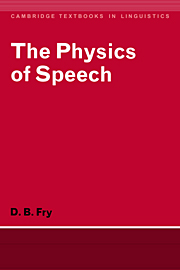Book contents
- Frontmatter
- Contents
- List of phonetic symbols
- 1 The speech chain
- 2 The generation of sound
- 3 The propagation of sound waves
- 4 Absorption and reflection of sound energy
- 5 Free and forced vibrations: resonance
- 6 The speech mechanism as sound generator
- 7 The vocal tract
- 8 Periodic and aperiodic sounds
- 9 Acoustic analysis: the sound spectrograph
- 10 Acoustic features of English sounds
- 11 Acoustic cues for the recognition of speech sounds
- Index
- Frontmatter
- Contents
- List of phonetic symbols
- 1 The speech chain
- 2 The generation of sound
- 3 The propagation of sound waves
- 4 Absorption and reflection of sound energy
- 5 Free and forced vibrations: resonance
- 6 The speech mechanism as sound generator
- 7 The vocal tract
- 8 Periodic and aperiodic sounds
- 9 Acoustic analysis: the sound spectrograph
- 10 Acoustic features of English sounds
- 11 Acoustic cues for the recognition of speech sounds
- Index
Summary
One of the facts of life which is rarely taught or even formulated is that it is not possible to get something for nothing out of nature. Whenever physical work has to be done, some supply of energy is required and the work actually consists in converting this energy from one form into another. The generating of sounds is physical work and it therefore depends on a suitable source of energy. Watching a large symphony orchestra at a moment when all the players are engaged is a good demonstration of the point; something over a hundred people are in movement at the same time, about three-quarters of them pushing their right arm back and forth, about one-fifth blowing and the remaining five per cent hitting things, using one or both arms. This constitutes the source of the energy which is being converted into the sound of the symphony orchestra playing fortissimo. If the sound is reduced until everyone is playing very quietly, it is obvious that much less energy is being expended, and if all the players rest, leaving the leader to play a solo passage on the violin, the amount is very much less still but energy must continue to be supplied by that one right arm.
The sound produced by the whole orchestra is very complex in the everyday sense since so many instruments are playing at once.
- Type
- Chapter
- Information
- The Physics of Speech , pp. 5 - 27Publisher: Cambridge University PressPrint publication year: 1979

